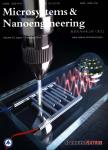A batch microfabrication of a self-cleaning,ultradurable electrochemical sensor employing a BDD film for the online monitoring of free chlorine in tap water
作者机构:Faculty of Electrical Engineering and Computer ScienceNingbo University315211 NingboP.R.China State Key Laboratory of Transducer TechnologyShanghai Institute of Microsystem and Information TechnologyChinese Academy of Sciences200050 ShanghaiP.R.China
出 版 物:《Microsystems & Nanoengineering》 (微系统与纳米工程(英文))
年 卷 期:2022年第8卷第2期
页 面:85-96页
核心收录:
学科分类:0830[工学-环境科学与工程(可授工学、理学、农学学位)] 08[工学] 080202[工学-机械电子工程] 0804[工学-仪器科学与技术] 0815[工学-水利工程] 0802[工学-机械工程] 0703[理学-化学] 0701[理学-数学] 0812[工学-计算机科学与技术(可授工学、理学学位)]
基 金:supported by a grant from the National Science Foundation of China(61871243).
摘 要:Free chlorine is one of the key water quality parameters in tap water.However,a free chlorine sensor with the characteristics of batch processing,durability,antibiofouling/antiorganic passivation and in situ monitoring of free chlorine in tap water continues to be a challenging issue.In this paper,a novel silicon-based electrochemical sensor for free chlorine that can self-clean and be mass produced via microfabrication technique/MEMS(Micro-Electro-Mechanical System)is proposed.A liquid-conjugated Ag/AgCI reference electrode is fabricated,and electrochemically stable BDD/Pt is employed as the working/counter electrode to verify the effectiveness of the as-fabricated sensor for free chlorine detection.The sensor demonstrates an acceptable limit of detection(0.056 mg/L)and desirable linearity(R^(2)=0.998).Particularly,at a potential of+2.5 V,hydroxyl radicals are generated on the BBD electrode by electrolyzing water,which then remove the organic matter attached to the surface of the sensor though an electrochemical digestion process.The performance of the fouled sensor recovers from 50.2 to 94.1%compared with the initial state after self-cleaning for 30 min.In addition,by employing the MEMS technique,favorable response consistency and high reproducibility(RSD4.05%)are observed,offering the opportunity to mass produce the proposed sensor in the future.A desirable linear dependency between the pH,temperature,and flow rate and the detection of free chlorine is observed,ensuring the accuracy of the sensor with any hydrologic parameter.The interesting sensing and selfcleaning behavior of the as-proposed sensor indicate that this study of the mass production of free chlorine sensors by MEMS is successful in developing a competitive device for the online monitoring of free chlorine in tap water.



